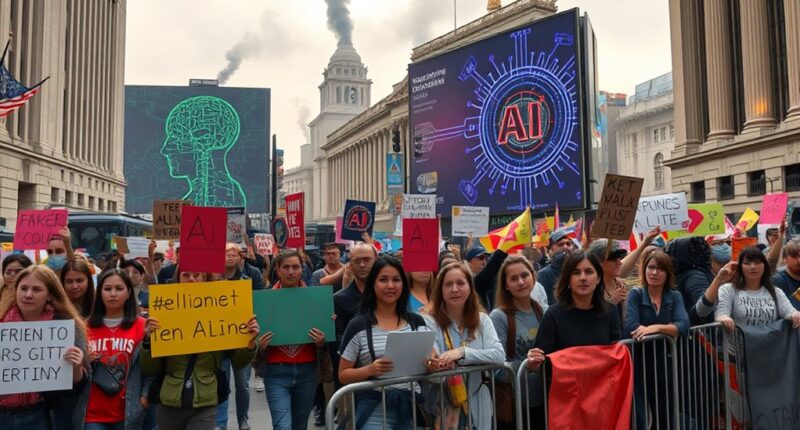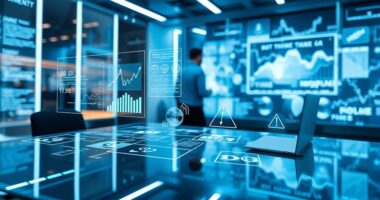As AI infrastructure expands globally with over $300 billion in investments, you’re seeing increased protests, stricter regulations, and environmental concerns cause delays and pushback. Communities and policymakers worry about rising energy costs, water use, and grid stability, which threaten the pace of development. These tensions are already shaping policies that could slow expansion and alter infrastructure plans. If you want to understand how these challenges impact AI growth worldwide, there’s more to uncover ahead.
Key Takeaways
- Growing environmental concerns from AI data centers’ high energy and water consumption are prompting protests and regulatory scrutiny worldwide.
- Local communities and regulators are pushing back against infrastructure expansion due to fears over power grid strain and ecological impacts.
- Delays in grid connections and infrastructure approvals are hindering AI deployment, leading to policy debates on sustainable growth strategies.
- Increased utility costs and infrastructural challenges are fueling societal resistance and calls for stricter environmental policies.
- Governments are reevaluating regulations to balance AI development with environmental sustainability amid rising public opposition.

AI Infrastructure: Pushback Worldwide
As AI infrastructure expands rapidly worldwide, it’s facing mounting pushback from governments, utilities, and communities concerned about its environmental, economic, and geopolitical impacts. You’re witnessing a surge in investments—over $300 billion on AI hardware, mainly GPUs, projected for 2025. Major tech companies are approaching $400 billion in capital spending, fueling a wave of mega data centers exceeding 300 MW in power draw. These facilities, some with transformer-level GPU densities of ≥ 90 kW per rack, are straining energy grids and raising sustainability questions. Cloud providers are building greenfield campuses across the globe to satisfy sovereign cloud mandates that demand physical separation from older regions, further expanding infrastructure footprints. In the U.S., construction spending on data centers hit a record $40 billion annually in mid-2025, a crucial 30% increase year-over-year, reflecting the scale of this digital race.
However, much of this hardware remains underutilized. Over 75% of organizations run GPUs below 70% capacity, even during peak workloads. You might not realize that AI workflows often spend 30–50% of their runtime in CPU-only phases, leaving GPUs idle and unable to contribute to processing. Static resource allocation locks GPUs into jobs for their entire duration, causing substantial compute waste and inflating operational costs. For expensive hardware like NVIDIA’s H100—costing around $40,000 each—idle periods translate into roughly $10,000 lost annually per GPU. This inefficiency acts as a silent tax on AI innovation, hampering progress and giving some companies a competitive disadvantage. Research indicates that optimizing GPU utilization could unlock billions in potential value and reduce unnecessary power consumption. Additionally, improving color accuracy in data processing can enhance overall efficiency and performance.
The energy demands of these data centers are also causing concern. They consume power equivalent to five million residential homes, surpassing the capacity of current U.S. nuclear or gas plants. This concentrated, continuous power draw creates grid challenges, including harmonic distortions, load relief alerts, and near-miss incidents. Nearly 80% of U.S. power and data center executives expect AI to considerably increase power demand through 2035. Yet, many grid connection requests face long delays—sometimes up to seven years—limiting the pace of AI expansion. Uncertainties in demand forecasts, supply chain disruptions, and rising infrastructure costs threaten to either overbuild or under-serve, complicating planning efforts.
Environmental impacts intensify as AI data centers are projected to consume up to 12% of U.S. electricity within a few years—almost triple current usage—placing immense strain on utilities and local water supplies. Cooling systems that circulate ultra-purified water are crucial but increase regional water stress, especially in areas with competing needs. Rising electricity costs due to AI infrastructure may also trickle down, raising utility bills for nearby residents and small businesses. As models are increasingly deployed closer to end-users to reduce latency, infrastructure decentralization adds further complexity to grid management. Supply chain constraints hinder the timely delivery of critical components, slowing the development of energy-efficient data centers and intensifying the pushback from communities and regulators alike.
Frequently Asked Questions
How Are Governments Regulating AI Infrastructure Globally?
You see that governments regulate AI infrastructure through various approaches. The EU enforces strict rules via the AI Act, focusing on safety, transparency, and risk management. The US lacks a unified law but promotes innovation with sector-specific guidelines and state laws. China pushes a all-encompassing plan emphasizing international cooperation, data security, and sustainable development. Globally, countries are increasing legislation, balancing innovation with safety, and fostering international collaboration to manage AI’s risks and benefits.
What Are the Main Concerns Fueling Public Protests Against AI?
You’re protesting AI mainly because of fears over mass surveillance and loss of privacy, as governments and corporations use facial recognition and monitoring tools to track your online and public activities. You’re also concerned about job automation, which could lead to unemployment and inequality. Additionally, you worry about military use of AI and authoritarian regimes exploiting these systems to suppress dissent, fueling demands for regulation and ethical oversight.
Which Industries Are Most Affected by AI Policy Shifts?
You’ll notice that manufacturing, finance, healthcare, and transportation are most affected by AI policy shifts. In manufacturing, automation replaces many jobs, while in finance, AI boosts productivity but automates roles. Healthcare sees increased AI integration, though less impact on employment. Transportation adopts autonomous vehicles, and policies influence how these industries grow or face restrictions, shaping job markets and operational practices across these sectors.
How Do AI Restrictions Impact Technological Innovation?
AI restrictions can slow down your innovation efforts by increasing operational costs and creating bureaucratic hurdles. They may also discourage your company from expanding or investing in new technologies, especially if regulations are overly strict or uncertain. Collaboration becomes harder, limiting knowledge sharing. These constraints can stifle creativity, reduce competition, and delay breakthroughs, ultimately making it tougher for your organization to stay ahead in the rapidly evolving AI landscape.
What Future Developments Are Anticipated in AI Regulation?
You can expect future AI regulations to become more extensive and harmonized globally, emphasizing transparency, accountability, and data privacy. New frameworks will likely require organizations to implement robust governance, conduct risk assessments, and guarantee human oversight. Privacy laws like GDPR and CCPA will influence AI development, and international standards will guide compliance. These developments aim to balance innovation with safety, fostering responsible AI growth while addressing ethical and security challenges.
Conclusion
As you watch AI infrastructure face mounting resistance worldwide, remember that change is like a river—sometimes slow, sometimes fierce, but always shaping the landscape. Your awareness and voice can steer this current, ensuring that progress doesn’t drown out ethics or safety. Just as a river finds its path, society will find its way forward. Stay informed and engaged, because shaping AI’s future is a journey where every ripple counts.









